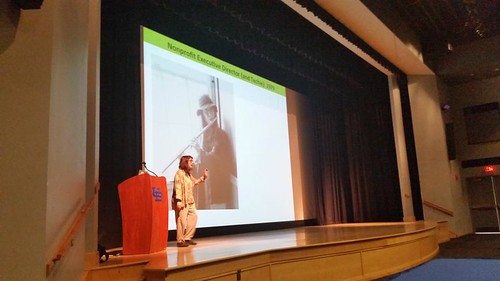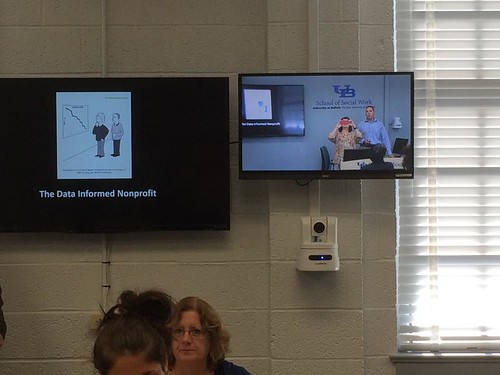
Last month, I spent two days teaching at University of Buffalo, School of Social Work. During my visit, I gave a keynote at a nonprofit leadership conference, facilitated a workshop for social work agencies on networks and data, guest taught a graduate course in social work research and evaluation methods, met with faculty, gave a talk on giving to students at the student union (pictured above), and was interviewed for the podcast series.
I love teaching (and learning) and it was a pleasure to work with students, nonprofits, and faculty. I also learned a lot working along side Nancy Smyth, Dean of the School of Social Work. One thing I realized is that training social workers receive as part of their education is also very relevant for change makers inside of nonprofits, consultants, and trainers.
Here’s a few frameworks and techniques I learned first hand from Nancy as she accompanied me to the sessions I was leading.
Over the past two decades of teaching workshops to nonprofits on the use of technology for mission-driven work and more recently on the use of online networks and data, people come workshops with different degrees of organizational readiness to embrace change that is needed to be successful. It is about simply learning how to use a new tool or technique.
Nancy used the phrase “pre-contemplation” and “contemplation” stages of behavior change and introduce me to a behavior change framework. As we all know too well, making a lasting change in behavior is rarely an easy or straightforward process. It typically involves a substantial commitment of time, energy, and emotion.
Understanding the elements of change, the stages of change, and ways to work through each stage is something that all technology trainers, capacity builders, and consultants should understand. And while this model is describing individual behavior, individuals make up organizations – so I think it is important for people working in organizations to understand, whether they are the executive director or the social media manager.
Here’s a quick overview of the framework:
- Stage 1: Pre-contemplation – This is denial where you think not changing is not a problem. I don’t often encounter people from nonprofits in this stage because they won’t attend a workshop or a peer learning activity. If they do, they are typically “resistant” learners, often questioning the value of the technology.
- Stage 2: Contemplation – This stage is where you learn more about the potential benefits of the change and what you have to “give up.” I get many participants in the stage, wanting to hear case studies of other nonprofits or what could go wrong. A typical question I hear at this stage in networking workshops, is “Where should we invest our time?” or “On what social channel can I find my audience?”
- Stage 3: Preparation –During the preparation stage, you might begin making small changes to prepare for a bigger change. This is where content that breaks down the practice into small steps is very useful to participants.
- Stage 4: Action – During this stage, people are taking direct action in order to accomplish goals. Oftentimes, they fail because the previous steps have not been given enough thought or time. Peer learning exchanges are a good model for supporting this – rather than have an expert consultant providing consultant, participants are taking action and learning together.
- Stage 5: Maintenance – During this stage, the direct actions become part of your everyday routine – they are internalized.
The model also talks about “relapses” and I see this a lot, especially with smaller organizations when they have a staff change or other priorities, the networked strategies they’ve adopted might get dropped. The key is to not feel frustrated, and pick it up again.

During the graduate course in evaluation and research methods, I gave an interactive lecture and lead discussion. We covered the themes of data informed organizations, best practices in learning from your data, and failure. The students, who would also be going out on field internships where they would conduct or assist with an evaluation project at a social service nonprofit, asked fantastic questions.
I loved this question: “How do we encourage learning from nonprofits from their evaluation data when they might view it as a report card?”
My thought is that many nonprofits need to have a growth mindset intervention.
I introduced a framework from Dr. Carol Dweck of Stanford University who has been studying people’s mindsets towards learning for decades. She has found that most people adhere to one of two mindsets: fixed or growth. People with fixed mindsets believe that they are only successful if they get a perfect score or an “A.” People with growth mindsets might get a “C” but they ask – how can I improve?
Dweck and others have developed techniques that they call ‘growth mindset interventions’ which have shown that even small changes in communication can have fairly long-lasting implications for a person’s mindset. In an educational setting, it boils down to praising people for the process versus the end result.
What might a growth mindset intervention for a nonprofit look like when going through a program evaluation process?
During the class, Dean Nancy Smyth related the idea to a social work technique called “Motivational Interviewing,” using in addiction interventions. Motivational interviewing does the following: 1) expresses empathy 2) helps individuals see the discrepancy between their perception of where they are now and where they want to be 3) avoid confrontation or arguments 4) rolls with resistance 5) supports effectiveness. I was even lucky enough to coax Nancy into an impromptu role play to model some of the techniques. I pretended to be a nonprofit staff member who was resistant to learning from data that showed a program had not reached it goals and she used the technique to get me change my perspective. She was brilliant!
What this experience reinforced in me is the importance of learning from adjacent practices or “transdisciplinarity” (literacy in and ability to understand concepts across multiple disciplines). It means not staying in your silo of knowledge and it can help you be a more innovative thinker.
How are you incorporating learning from adjacent practices or fields into your professional learning?

Leave a Reply